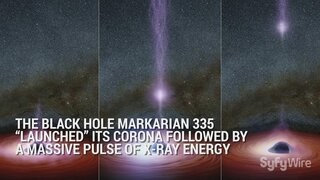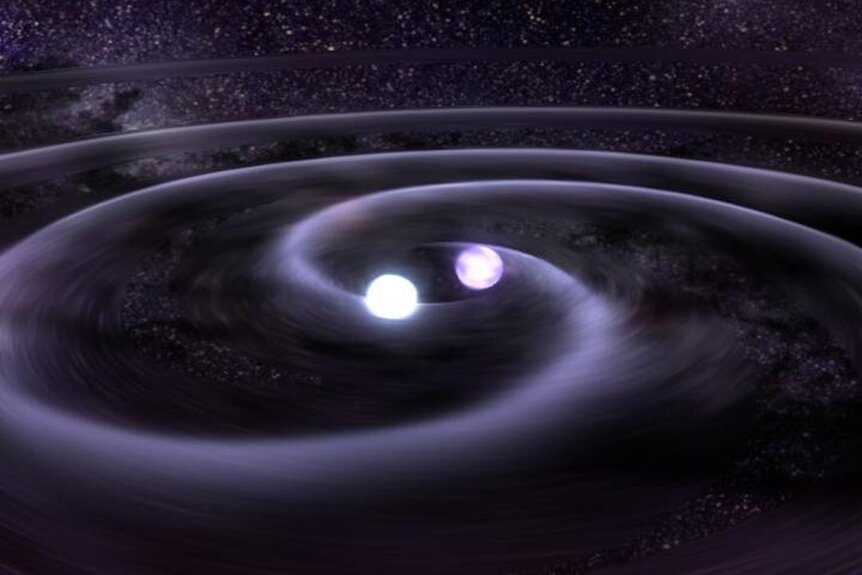Create a free profile to get unlimited access to exclusive videos, sweepstakes, and more!
Mysterious radio signal follows gravitational waves like cosmic thunder and lightning
You're going to need a bigger umbrella.

In the course of day to day life, its easy to forget that the universe is busy smashing together objects more massive than the Sun and creating unimaginably small and dense singularities. It’s out there, making new stars from gas and dust, building planets of every conceivable size and composition, and (in at least once instance) making little creatures who can look up to the night sky and ask, “What the frak is that?”
Scattered in among the stars, planets, nebulae, and galaxies that astronomers study, they sometimes pick up rare and short-lived radio signals from deep space. These fast radio bursts (FRBs) last only milliseconds and most of them never reappear. Despite their rarity and short lifespan, FRBs carry an incredible amount of power. It’s estimated that some of the FRBs we’ve detected have been the result of an energy release on the scale of half a billion Suns.
They are powerful, they are unannounced, and we don’t know for sure what causes them. They are the sort of cosmic phenomenon which practically begs for an alien explanation. If Harry Vanderspeigle (played by Alan Tudyk on SYFY’s Resident Alien, streaming now on Peacock!) were here, he’d surely tell us they are the result of some incredible alien weapon or communications system we couldn’t begin to imagine. But he isn’t here, so we have to rely on the talents of humanity’s brightest minds. You can find them at the top of a recent paper published in the journal Nature Astronomy.
RELATED: Alan Tudyk gives an alien hand thumbs up from set of SYFY’s ‘Resident Alien’ Season 3
Because of their rarity, astronomers can’t simply point their detectors at an incoming FRB, because they don’t know where to point. All of our detections, more than 600 to-date, have resulted through happy accident when astronomers happened to be pointing their instruments at the right part of the sky at the right time.
The leading hypothesis for their cause is young magnetars, a type of neutron star with an overactive magnetic field. The field wants to expand but it’s pulled in by the intense, nearly overwhelming pull of the neutron star’s gravity. The result is a sputtering, flaring field which occasionally sends intense radio bursts out into space. That could explain some FRBs, and in fact seems to be the explanation for one which occurred inside our own galaxy in 2020, but scientists aren’t convinced that’s the whole story.
Now, however, scientists have another lead, thanks to yet another happy coincidence, this time at two separate labs. On April 25, 2019, scientists at the Canadian Hydrogen Intensity Mapping Experiment (CHIME) picked up a bright FRB coming from about 520 million light years away. Two and a half hours earlier, scientists at the Laser Interferometer Gravitational-Wave Observatory (LIGO) detected a gravitational wave event from roughly the same location. The fact that they both occurred at roughly the same time and from roughly the same region of space seemed too much of a coincidence. In fact, scientists calculated the odds at about one half of one percent.
That’s about as close to a smoking gun as you can hope for. The LIGO detection occurred when two orbiting neutron stars collided and merged, sending ripples through spacetime itself. It’s the collision that would have caused the gravitational waves and been picked up at LIGO, but the FRB resulted from what happened over the next couple of hours.
The two neutron stars were already incredibly dense, that’s one of their essential defining characteristics. Neutron stars are comprised of tightly packed neutrons all pressed together like sardines. Neutron stars are the most dense stars (read: the most dense three-dimensional objects) in the universe. They cannot get any denser and still have dimension, because their particles are already as close as they can physically be. They are prevented from further collapse by quantum degeneracy pressure, which basically demands that no two particles exist in the same space at the same time. After the collision, the same rules apply, but now the combined object is dealing with a lot more mass. So much mass that it is capable of overcoming quantum degeneracy pressure and collapsing into a singularity, but it doesn’t, at least not for a little while.
RELATED: Breakthrough! Mysterious radio signal traced to a galactic minimonster
Just after the collision, the new and more massive star is still spinning rapidly. The spin pulls material away from the center, like a ball swung from the end of a rope. As the spin slows down, the outward pull diminishes, fails, and the system collapses. The magnetosphere is expelled, generating an FRB, as the neutron star collapses into a shiny new black hole.
The 2.5 hour time delay between gravitational wave detection and FRB detection is consistent with the survival time of the combined neutron star before collapsing. If you’re pointing the right instruments at the right objects at the right time, you can pick up both signals, one following shortly after the other, like the distant rumble and crackle of cosmic thunder and lightning.
The universe is wonderful and exciting, even if it is filled with aliens who want to take our planet for their own. Forestall the alien apocalypse with Resident Alien, streaming now on Peacock!















